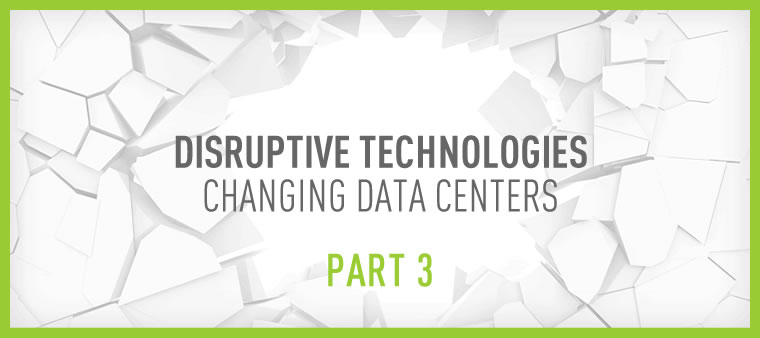The Raritan Blog
Home » The Raritan Blog » Disruptive Technologies Changing Data Centers: Part 3
Disruptive Technologies Changing Data Centers: Part 3
Posted on August 14, 2018 by Gento

Disruptive technologies will have the unique opportunity to positively impact data centers. In Part 2 of this series, we explored two technologies that are staged to change the very system and infrastructure of IT systems. In this final portion of our disruptive technologies series, we want to take a look at two technologies that will bring heightened levels of agility to data centers for a fraction of the cost.

Disruptive Technology #1. Open Source Infrastructure
Reports indicate that some of the largest data center operators have already begun to adopt open architectures meaning deploying technologies that allow easy modification and updates. This adoption is done to not only lower costs but to also glean the benefits of simplification and standardization. With an open source infrastructure, data center operators will be able to realize savings by leveraging a bare-bones IT hardware solution.
Who will adopt this technology?
- Companies that supply 3-phase UPS systems, as well as VRLA batteries.
- Rack suppliers.
- Companies responsible for the original equipment manufacturing of servers.
Why will this technology continue to be adopted?
- Reduced Overhead And Capital Expenses. -- One of the primary reasons for using an open source infrastructure within data centers is to reduce capital expenses.
- Improved Thermal Management. -- A wider temperature band could result in a more energy-efficient cooling solution.
- Easier Serviceability. -- When hardware is easy to access, it is easier and far less expensive to repair, maintain, upgrade, or decommission.
Open source infrastructure currently represents up to three percent of global data center spend. However, interest is on the rise, which means that data center operators will need to continue to drive down costs as they increase agility. The adoption of open source infrastructure within data centers might be slow, but the potential ramifications will likely be significant.

Disruptive Technology #2. Software-Defined Power
A software-defined data center is where all components including compute, storage, networking, and security—are virtualized, or decoupled from specific physical hardware and software-defined power is based around creating a layer of abstraction that will continuously match power resources with the ever-changing needs of the data center. The reason behind this disruptive technology is two-fold -- 1) to achieve significant cost savings, and 2) to improve the agility of the data center by treating its power as a virtual resource that can be effectively managed.
Who will adopt this technology?
- Data center operators who need to more effectively manage the use of IT and facilities in a symbiotic fashion.
- Data center operators interested in reducing the demand for cooling systems.
- Systems who have not yet invested in software-defined power.
Why will this technology continue to be adopted?
- Heightened Levels Of Capacity Management. -- The primary benefit of software-defined power is its ability to properly complete capacity management tasks to effectively meet the changing needs of data centers.
- Improved Utilization. -- Those enterprises interested in enjoying lower costs will need to first achieve improved utilization through software-defined power.
- Increased Ability For Segmentation. -- The ability to reduce over-provisioning and subsequently enjoy segmentation that is based around prioritized redundancy levels for workloads can result in numerous data center benefits.
If software-defined power can offer the same availability for mission-critical applications as physical equipment can, then the argument for its adoption is won. Additionally, this disruptive technology offers the clear benefit of lowered costs without adding any additional risk. Finally, if data centers use software-defined power, and other disruptive technologies, to operate at higher utilization levels, then the data centers themselves could in effect become cheaper and smaller.
The Adoption Of Disruptive Technologies Will Continue In Data Centers
One thing is certain, disruptive technologies such as open source infrastructure and software-defined power will continue to be adopted within data centers. As seen with the Chiller free and micro-embedded technologies discussed within Part 1, as well as the Storage-class memory and silicon photonics technologies discussed within Part 2, the world of data centers will continue to evolve as new disruptive technologies enter the marketplace.
###
Sources:
- https://www.hpe.com/us/en/what-is/software-defined-data-center.html
Other Blog Posts
- The cascade effect of data center failure on businesses - why sensors are essential
- Posted on November 5, 2023
- The Rapid Growth of AI and the Use of Raritan PDUs to Meet Higher Power Demands
- Posted on October 11, 2023
- Data Center Report Fewer Outages, But Downtime Still Costly
- Posted on September 20, 2023
- Survey: Energy Usage and Staffing Shortages Challenge Data Centers
- Posted on September 20, 2023
- Raritan Secure Switch: Secure NIAP 4.0 Compliant Desktop KVM
- Posted on September 20, 2023
Subscribe
Upcoming Events
- New Zealand Cloud & Datacenter Convention 2022
- 3 November 2022, 9am – 4pm • Grand Millennium Hotel, Auckland, New Zealand
- Data Centre World Singapore
- 12th – 13th Oct 2022
- Korea Cloud & Datacenter Convention 2022
- 6th Oct 2022
- Philippines Cloud & Datacenter Convention 2022
- 4th Aug 2022
- JANOG50 Meeting Hokkaido
- 3th – 15th July 2022
Latest News
- Legrand Revitalizes Data Center Sector with Two Revolutionary Intelligent Rack PDUs
- Posted on May 1, 2023
- Exclusive interview丨How does Huizhou upgrade its manufacturing industry?
- Posted on December 2, 2021
- Raritan Reveals The MasterConsole® Digital Dual KVM Switch
- Posted on February 18, 2021
- Legrand Data, Power and Control Division Announced as Finalist in Six Categories at DCS Awards 2020
- Posted on November 9, 2020